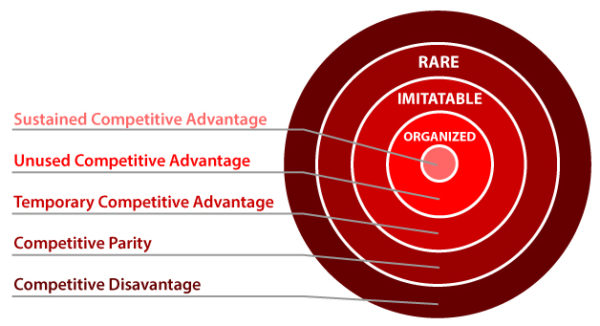October 28, 2019
Internal Growth Strategies to Build Your Business

There are many ways to build your business, but cleaning house is always the best way to start. Internal growth or organic growth focuses on developing your current workforce, investing in better equipment and expanding the company’s internal resources and capabilities.
One great methodology would be to start with a VRIO Framework to understand what your core competencies are and what assets the company has that can create a sustained competitive advantage in the future.

VRIO stands for Valuable || Rare || Inimitable || Organized. Let’s examine these values.
Value
How do your customers think you add value? Can you exploit that value by turning it into an opportunity or neutralize your competition? If not, you are at a competitive disadvantage and need to review your core competencies and current offering to uncover what you can offer that would add value. For example, what if you made rubber bands? How could you differentiate your from your competition? Why should someone buy your rubber bands over another? Let’s say that your rubber bands are made of a special rubber that is twice as strong and comes in several colors and widths. You could explore what people use them for and create value for new consumers such as the DIY carpenter using your large bands for clamps. Maybe the colors would attract crafters. Keep looking until you see a way to present your offering that adds value to customers.
Rarity
Do you have total control over a scarce resource? Do you have very specific capabilities that clients would pay a premium to gain competitive advantage over their competition? For example, in the commodities markets, millions of dollars can be lost in a fraction of a second. Having the software that is just a fraction of a second faster or that can process more orders simultaneously could be extremely valuable. If you have realized your value, but in a crowded market with several competitors selling virtually the same software, your company is in a position called competitive parity. Your software may be valuable, but not more valuable to the customer because there are others who also offer similar products or services.
Imitability
Would it be easy for your competition to replicate your success? Would your customers have difficulty finding similar products or services in the marketplace? Would they experience pain in transitioning from your service to another? One good example is Software as a Service (SaaS) software. It is by nature, low cost and built into small affordable components to enable small and medium sized businesses to manage their finances, employees, legal matters, etc., expanding services by adding new components as they grow. HR software is a good example of difficulty of conversion. Say you initially purchase the payroll component to manage your employee’s salaries. This takes a lot of work to set up, entering each employee into the system and ensuring all the data is correct. As you add in the leaves management component, the talent acquisition component, and performance reviews component, it becomes increasingly more difficult for the customer to move to another vendor because the work to convert would outweigh any initial advantages the competition can promise. If your product or service easy to replicate and the cost to convert is simple, you only have a temporary competitive advantage.
Organization
Most startups are filled with chaos. There’s typically no on-boarding. There’s no paper trail for getting leaves approved, you don’t know how to get a stapler… let alone where your documents are printing because they’re never there at the printer in your department. There’s a pain point in all growing companies where all the organization and structure needs to be formally introduced and the change managed all the way to the top of the organization. Strategic communications needs to be formalized. Without this, your company will suffer from unused competitive advantage. There are specialists out there that focus on this move from startup to the next level. It’s not number of employees, or the amount of revenue you’re making. What you’ll see is employee churn. The grapevine becomes the only way people learn what’s going on within the company and that’s never good. You may start losing customers because your customer service isn’t responsive. Find people with experience that can advise you on creating this structure rebuilding your business without losing your unique corporate culture (or maybe that’s part of the problem). If you manage to set standard operating procedures (SOPs) into place for each department, formal job descriptions, paper-based or electronic employee management, you will have achieved sustained competitive advantage.
Okay, now that you’ve cleaned house and have a better understanding of your internal assets and capabilities, it’s now time to look at plans for organic growth. Let’s say your company is managing a profit margin that’s fairly healthy and you have liquidity to look at new opportunities for expansion. It can be as simple investment in faster, modern equipment or robotics to increase throughput in your current factory. It could be expanding the size of your factory to do the same. It may be starting completely new, symbiotic businesses or entering a greenfield market where this product or service has never been sold before. Organic growth is great for your business because:
1. Deeper Knowledgebase: when investigating new opportunities, your senior employees learn more about the options available and learn more through direct involvement in researching that new market or technology. This knowledge is likely to be internalized within the organization and used to make better, more informed decisions when planning growth strategies for your company.
2. Spreading Investment Over Time: gradual growth minimizes the risk since the upfront costs and commitments to major projects can be intense, making it difficult to adjust your plans later if market conditions change. Gradual growth also enables you to provide just-in-time training for your employees, set up standard operating procedures, and manage change through frequent communications with affected departments.
3. No Issues with Availability: You are not dependent on any outside resources, such as consultants or partners, nor do you need to create strategic alliances or acquire companies, so you can identify opportunities, research their feasibility, create prototypes or MVPs and approach customers based on your own internal timeline. Another aspect to this is not having to wait for a perfectly matched acquisition target to appear on the market for you to get started.
4. Strategic Independence: When setting up strategic alliances or partnership agreements, it usually requires negotiation and compromise because both sides have their own agendas and expectations. Alliances and partnerships may require exclusivity clauses, limiting other future opportunities. There can be performance or quality issues that can reflect badly on your company through no fault of your own. Being independent enables you to chart and manage the growth of your company your way, based on your esoteric knowledge of your industry and your customers.
5. Change Management: organic growth facilitates now processes and activities to be communicated through timely emails, company-wide meetings, departmental training and other communications that are appropriate within your existing corporate culture. Maintaining an “open door” policy will enable employees to share their concerns and ideas for improvement. Take the policy seriously and formalize how you respond to new ideas from employees. Respond in a timely manner. Give credit where it is due. The best ideas will come from the lower levels of the company, so don’t discount the janitor’s idea just because he’s the janitor. He’s more in touch with the daily activities of the company than any manager.
Internal growth does have a few disadvantages. Developing internal capabilities can be slow and time-consuming, expensive, and risky if not managed well. Your managers and top level employees really need to understand and support the plans for growth so selling the idea to them before any money is invested is critical. Without middle management support, there can be passive aggressive delays, critical employees quitting, even sabotage, that can derail even the best of strategies. For example, maybe you’ve decided to invest in robotics to automate some of the more time consuming and repetitive components on your production line. Some employees and managers may fear that they will lose their jobs because of this plan. Being proactive about retraining opportunities, options for reassignment within the company and other options will enable managers to discuss the plan more positively and allay any concerns employees may have about your plan.
So think big. Open your mind by asking yourself, “if I had all the money I needed, all the right staff in place, and all the time I needed, what could I do to create growth in my business?” Ask this of your employees as well.
